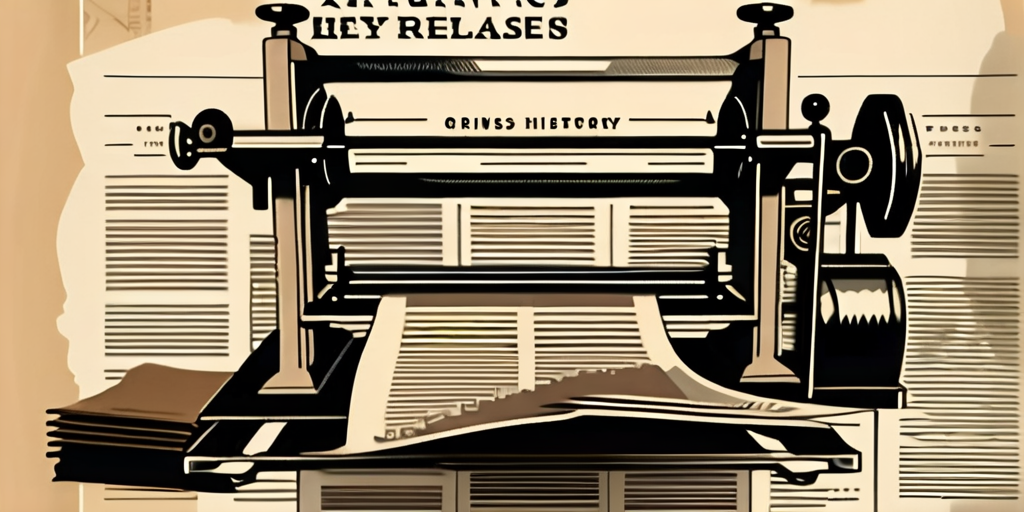
In the field of public relations, a press release is a written communication that reports specific but brief information about an event, circumstance, or other happening. It’s typically tied to a business or organization and is provided to media through a variety of means.
Press releases are an essential tool in the public relations industry. They are a primary method of communicating news and announcements to the media and the public. They provide a way for organizations to promote themselves, their products, or their services, while also providing journalists with material for a potential story.
Origins and History of Press Releases
The press release has been a mainstay of public relations since the early 20th century. Ivy Lee, often considered the founder of modern public relations, created the first press release in 1906 for the Pennsylvania Railroad, following a fatal accident. The release was provided to journalists at the scene and was also made available for newspapers to reprint verbatim. This was a revolutionary concept at the time, as it allowed the company to control the initial public message about the incident.
Since then, the press release has evolved and adapted to changes in media and technology. However, its core purpose remains the same: to provide journalists with information that they can use to develop a news story.
Press Releases in the Digital Age
With the advent of the internet and digital media, the press release has undergone significant changes. Today, press releases are often distributed via email or through online distribution services. They are also commonly posted on a company’s website or social media pages. These changes have made press releases more accessible to a wider audience, including consumers and investors, not just journalists.
Despite these changes, the basic format of a press release remains largely the same. It typically includes a headline, a brief summary, the body of the release, a company boilerplate, and contact information. The body of the release is where the news or announcement is detailed, while the boilerplate provides background information about the company or organization.
Components of a Press Release
A well-crafted press release contains several key elements. The headline should be catchy and concise, effectively summarizing the news in a way that will grab the reader’s attention. The lead, or first paragraph, should provide the most important information, following the journalistic principle of “inverted pyramid” structure. This means that the most newsworthy information is presented first, followed by details and background information.
The body of the press release should provide more detailed information, including quotes from key individuals involved. These quotes provide a human element to the story and can provide additional insight or perspective. The press release should conclude with a boilerplate, a short paragraph that provides background information about the company or organization issuing the release. Finally, the press release should include contact information for journalists who may have further questions or need additional information.
Writing a Compelling Headline
The headline of a press release is arguably its most important component. It’s the first thing that people see, and it can determine whether or not they decide to read further. A compelling headline should be concise, clear, and catchy. It should effectively summarize the news in a way that piques the reader’s interest.
When writing a headline, it’s important to keep in mind the audience. The headline should be written in a way that is relevant and interesting to the target audience. It should also use language that is easy to understand and avoid jargon or technical terms that the average reader may not understand.
Creating a Strong Lead
The lead, or first paragraph, of a press release is also critical. It should provide the most important information about the news or announcement. This includes the who, what, when, where, and why of the story. The lead should be concise and to the point, providing the key details in a clear and compelling way.
Like the headline, the lead should be written with the audience in mind. It should provide information that is relevant and interesting to the target audience. It should also be written in a way that is easy to understand, avoiding jargon or technical terms.
Press Release Distribution
Once a press release has been written, it needs to be distributed. This is typically done through a press release distribution service, which sends the release to a network of journalists and media outlets. The distribution service may also post the release on its website, making it accessible to the public.
When choosing a distribution service, it’s important to consider the service’s reach and reputation. A service with a wide reach can get the press release in front of a large number of journalists and media outlets, increasing the chances of the news being picked up. The reputation of the service is also important, as it can affect how the press release is perceived by the media.
Targeting the Right Audience
When distributing a press release, it’s important to target the right audience. This means sending the release to journalists and media outlets that cover the relevant industry or topic. By targeting the right audience, the chances of the press release being picked up and turned into a news story are significantly increased.
Targeting the right audience also involves considering the timing of the release. The release should be sent out at a time when it is most likely to be seen by the target audience. This may involve considering the news cycle, the time of day, and the day of the week.
Following Up
After a press release has been distributed, it’s important to follow up with journalists and media outlets. This can involve sending a follow-up email or making a phone call to ensure that the release was received and to answer any questions. Following up can increase the chances of the press release being picked up and turned into a news story.
However, it’s important to be respectful and not overly pushy when following up. Journalists are often busy and receive many press releases each day. Being respectful and understanding of their time can help build a positive relationship and increase the chances of future press releases being picked up.
Measuring the Success of a Press Release
Measuring the success of a press release can be challenging, but it’s an important part of the process. There are several ways to measure the success of a press release, including media coverage, social media engagement, website traffic, and business outcomes.
Media coverage is the most direct measure of a press release’s success. This involves tracking which media outlets picked up the release and turned it into a news story. Social media engagement can also be a good indicator of success, as it shows how the news is being received by the public. Website traffic can show how many people are visiting the company’s website as a result of the press release. Finally, business outcomes, such as sales or new customers, can show the direct impact of the press release on the business.
Using Analytics Tools
There are many tools available that can help measure the success of a press release. These tools can track media coverage, social media engagement, website traffic, and other metrics. Using these tools can provide a more accurate and detailed picture of the press release’s impact.
However, it’s important to keep in mind that these tools are just one part of the measurement process. They should be used in conjunction with other methods, such as direct feedback from journalists or customers, to get a complete picture of the press release’s success.
Understanding the Limitations
While it’s important to measure the success of a press release, it’s also important to understand the limitations of these measurements. Not all press releases will result in media coverage or a spike in website traffic. Sometimes, the success of a press release is more subtle and long-term.
For example, a press release may help build relationships with journalists, leading to increased media coverage in the future. Or it may help raise awareness of the company or organization, even if it doesn’t immediately result in sales or new customers. These are important outcomes that may not be immediately measurable, but are still valuable.
Conclusion
In conclusion, the press release is a powerful tool in the field of public relations. It allows companies and organizations to communicate news and announcements to the media and the public in a controlled and effective way. While the format and distribution methods have evolved over time, the core purpose of the press release remains the same.
By understanding the components of a press release, how to distribute it effectively, and how to measure its success, public relations professionals can use this tool to its full potential. Whether it’s announcing a new product, sharing company news, or responding to a crisis, a well-crafted and well-distributed press release can make a significant impact.




